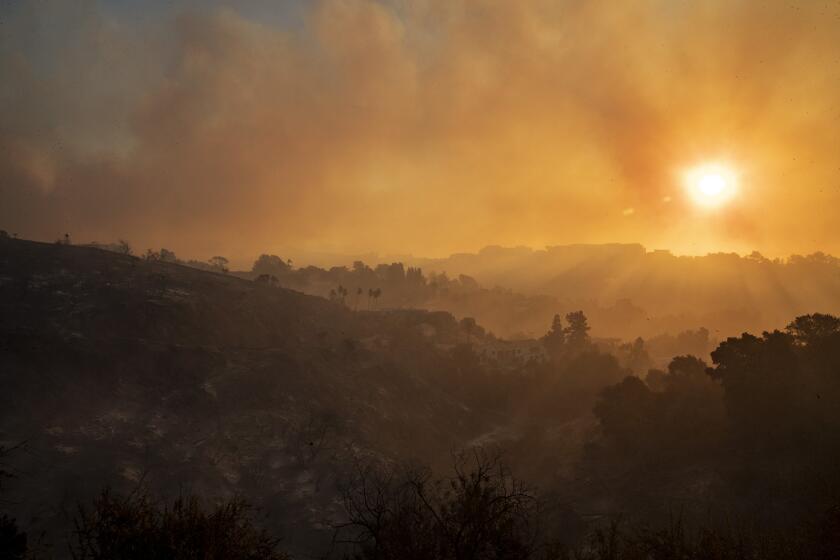Two big California wildfires erupted. Now L.A. and the Bay Area are breathing the smoke

- Share via
Even for those miles away from the flames and power outages, smoke plumes from California’s wildfires are disrupting people’s lives, degrading air quality from the Bay Area to L.A.’s Westside and contributing to widespread school closures.
More than 10,000 students across the Santa Monica and Malibu areas were forced to stay home Monday after being alerted about 6:30 a.m. that all schools in their district would be closed because of the Getty fire.
District officials said wildfire smoke was one of several reasons they closed all 16 of their schools, even those far from any direct fire danger.
“Air quality is unhealthful in many neighborhoods. Traffic is jammed. We are still under notice for Public Safety Power Shutoffs in Malibu, along with a red flag warning, meaning extreme fire danger,” Santa Monica-Malibu Unified School District Supt. Ben Drati wrote in a message to parents and staff Monday afternoon. “These conditions are what led us to our decision, in an abundance of caution.”
Later in the day the South Coast Air Quality Management District issued a smoke advisory warning of elevated pollution through Tuesday morning as winds push the smoke over areas of the Westside, the Santa Monica Mountains, the San Fernando Valley and central Los Angeles.
The advisory cited “very unhealthy” air quality in communities near the Getty fire based on readings from low-cost pollution sensors in Brentwood showing elevated levels of fine-particle pollution early Monday morning.
The district’s own monitoring stations in downtown Los Angeles and Reseda were not showing elevated pollution levels “in part because winds are pushing smoke away from the monitors,” according to the advisory.
But that could soon change. Forecasters predicted shifting winds to push smoke from the fire to the east and northeast toward downtown Los Angeles, Burbank, and the San Fernando Valley, on Monday afternoon, then north toward the San Fernando Valley, Thousand Oaks, Simi Valley and Burbank on Tuesday.
The pathway of the smoke is only as predictable as the wind and, regulators said, can shift at a moment’s notice.
Gail Pinsker, a spokeswoman for the Santa Monica-Malibu district, said, “We did not wake up expecting to close schools today,” but that poor air quality from the Getty fire meant that children would have had to stay indoors.
“We don’t have air conditioning in all of our classrooms, so when it’s hot like this in addition to the conditions, we can’t have a classroom full of students with windows closed and without air conditioning,” she said.
Air quality in the L.A. Basin has worsened along with the Getty fire. Here’s a list of those who should take extra care as air quality deteriorates.
The Los Angeles Unified School District closed more than a dozen schools because of the Getty fire, though officials said those closures were based on their proximity to evacuation zones, not air quality. UCLA canceled classes. Santa Monica College closed its campus, citing air quality concerns.
In the Bay Area, air quality officials said air quality had degraded considerably Monday and warned that smoke from the Kincade fire was expected to push south into the Bay Area, combining with smoke from the local Suisun Marsh fire.
Monitoring data shows air pollution reached “unhealthy” levels in communities in the East Bay and the North Bay by Monday morning, but regulators acknowledged there were localized spikes where people were breathing even higher pollution levels for shorter periods of time.
Air quality officials warned that shifting winds could as soon worsen pollution in the Bay Area by reversing conditions that, so far, have sent much of the smoke from the Kincade fire out over the Pacific Ocean.
“Right now we have smoke that’s sitting off in the ocean,” said Walter Wallace, a spokesman for the Bay Area Air Quality Management District. “If we have a weather pattern that blows that smoke into the Bay Area, we’re going to be impacted even more.”
In Southern California, many residents have gotten used to the threat of fires and of smoke pollution nearly every fall. “There’s always a threat hanging in the air around here,” said Danny Cahn, 62, who spent part of Monday snapping photos of firefighting helicopters and planes flying over his neighborhood, sandwiched between Bel-Air and Brentwood.
Early Sunday morning, Cahn and his wife were awakened by the smell of smoke wafting in through a bedroom window, he said.
“When the smoke clears and the fires are out,” he added, “it’ll be a wonderful place to live, until the next wildfire.”
Experts say that smoke from the blazes can irritate the eyes, nose and throat, trigger asthma attacks and raise the risk of heart attacks and stroke. Tiny, harmful particles in the smoke can lodge deep in the lungs and pose serious health risks, especially to children, the elderly and people with asthma and other chronic lung diseases.
The American Lung Assn. and other experts recommend taking precautions if you smell smoke or see ash in the air:
- Stay indoors with windows, doors and fireplace dampers closed.
- Avoid exercise or vigorous physical activity.
- Set your air-conditioning unit or car ventilation system to “recirculate” to keep outside air from entering.
- Run an air-cleaning device with a HEPA filter and place it in a single “clean room” within your home.
- Don’t rely on dust masks. A properly fitting N95 mask can filter out lung-damaging particles but can be difficult to use.
Times staff writer Louis Sahagun contributed to this report.
More to Read
Sign up for Essential California
The most important California stories and recommendations in your inbox every morning.
You may occasionally receive promotional content from the Los Angeles Times.













